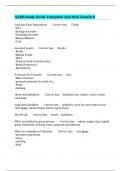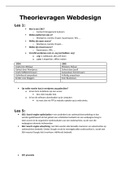Innovation and Technology Management - Final Exam
PART I – WHAT IS INNOVATION?
Chapter 1 – Introduction
Silicon Valley is the home of innovation. No other place one earth has been the location of so many
innovations (e.g. Apple and eBay). It has the highest concentration of high technology businesses on
earth. Silicon Valley’s unique feature is it capability for developing new technologies and exploiting them
commercially; the capability for innovation [Mini Case]
• What is innovation?
- Innovation ≠ Invention Innovation ≤ Invention since not all inventions become (successful) products
in the marketplace. But why? the commercialization process required to get an invention ready for the
market is lengthy and demanding, and at the same time requiring a different range of capabilities.
- An innovation is a commercialized invention that is new, novel, and different.
- Innovation defined: “Innovation embraces both a technological and a creative dimension, that we
normally refer to as invention, together with a commercial dimensions that involves the exploitation of the
invention to turn it from a model/prototype into something available in the market for consumer
purchase.”
- The scope of innovation: how new and different does something have to be to make it an innovation?
= The degree of novelty can be modest Two aspects of “newness” are:
1] New to the market – something similar could have already been offered in other markets
2] New to the company – less scope for
novelty because other firms may already
been offering it
= Degrees of Innovation
It identifies a number of
common forms of
innovation and serves to
highlight how the degree
of novelty can vary.
- Completely new products (e.g. Apple Ipod) have the highest degree of innovation.
- Line extensions (score moderately on both axes) new attributes to existing products. Line is extended to
, enable the product to appeal to a new group of consumers (Pharmaceutical industry: painkillers for kids,
this product was in its time an innovation but the degree of novelty is now limited).
- There will generally be less novelty with product re-positionings (Häagen Dazs) and new product lines.
• Innovation: invention – commercialization – diffusion
- The process of innovation: invention commercialization diffusion
1. Invention phase = new ideas, discoveries or breakthroughs are turned into workable inventions.
- When invention is technological in nature, there is much experimentation in this phase. If the invention
is a modest one with little novelty (line extension , re-positioning) there may be little/no experimentation.
- There are three routes to invention (three ways how the invention phase can be undertaken):
I - Individual (Heroic) = rare nowadays, classis model of invention. E.g. Google, Dyson.
II – Corporate (Closed) = corporate model of invention; R&D. E.g. AT&T
III – Open = newly emerged model; use of external sources such as licensing
from other large firms, or spin-offs without money.
2. Commercialization phase = activities that facilitate the introduction of new or improved products and
services onto the market . It is an expensive and lengthy process. Encompasses the development part of
R&D (to ensure safety, reliability, and capability of being produced in large quantities) plus the business
activities of marketing, organization and finance.
- Inventions only release value when consumers buy them; the technological potential of an invention
must be transformed into economic value (commercially available sold products).
- Commercialization mechanisms for bringing an invention to the market are described as ‘business
models’ which is a tool that allows inventors to profit from their ideas and inventions. How does a
business model enable innovation? = It performs two important functions of commercialization:
I - Value creation = refers to a series of activities that enable the user to recognize
the benefit and thence the value that can be gained from the invention,
without articulation of the value proposition customers will not buy.
II - Value capturing = appropriating value from the activities undertaken by the inventor.
e.g. revenue on the basis of a revenue generating mechanism (Iphone
became a platform for others to invest in regarding Apps).
- There are three general business models (these determine who undertakes the commercialization phase):
I – Incorporate technology into the current business (mostly used. E.g. Apple)
II – License the technology to a third party (also happens often. E.g. Dyson initially)
III – Launch a new venture to exploit the technology in new business arenas (E.g. Dyson)
3. Diffusion phase = not part of innovation but it is closely associated with it; it described the rate at
which consumers adopt and use the innovation (e.g. rapid diffusion of internet services such as FB).
- Normal diffusion pattern is a S-curve: early adopters – majority – laggards
- Why is the diffusion path S shaped? = bandwagon effect social factors (social networks, peer
pressure) Potential adopters are keen to jump aboard and adopt an innovation for the fear of being left
behind.
Chapter 2 – Types of innovation
- This chapter builds on the discussion of the scope of innovation in the previous chapter
• Making sense of innovation
- Grouping innovations into categories can help demarcating the concept of ‘innovation’












